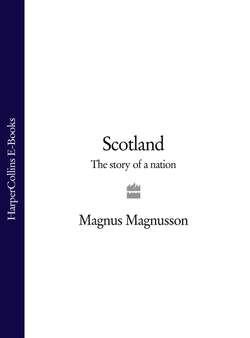Читать книгу Scotland: The Story of a Nation - Magnus Magnusson - Страница 15
Crannogs
ОглавлениеDeep in the heart of Perthshire, in the village of Kenmore at the eastern end of Loch Tay along the A827 from Aberfeldy, the historical enthusiast comes upon an extraordinary structure beside an embryo marina. On a solid platform of pile-driven wooden stilts in the water stands a massive wooden, thatched round-house. It is a crannog, reconstructed by the Scottish Trust for Underwater Archaeology.
Crannogs were, essentially, loch-dwellings built on artificial or modified natural islands in inland waters. They were usually linked to the shore by timber walkways or stone causeways, for protection against robbers or invaders. They were built by some of the first farmers in Scotland towards the end of the Neolithic Age (3000 BC), and some of them were still inhabited as late as the seventeenth century AD. Eighteen crannogs have been found in Loch Tay alone; hundreds more have been identified the length and breadth of Scotland north of the Central Belt. Some remain hidden as submerged stony mounds, others have become tree-covered islands. They were mini-castles long before castle-building began in Scotland.
The Kenmore crannog is based on ‘Oakbank crannog’, on the northern shore of Loch Tay at Fearnan (‘Place of the Alder’), which was built around 500 BC, at the start of the Iron Age, and was the first crannog in Scotland to have been thoroughly excavated underwater. The round-house has a floor of stout alder-logs thickly carpeted with bracken. It is furnished with all the kinds of artefacts which the excavation produced: a central flat-stone hearth for cooking and heating, storage areas for provisions, wooden bowls and plates, leather clothes and shoes and bags, jewellery made from jet or polished stone, woven and dyed textiles. It makes an unexpectedly roomy homestead for an extended family of perhaps fifteen to twenty people.
The crannog-dwellers on Loch Tay were farmers, even though they lived on water. They tilled the adjoining land and grew barley and two different types of wheat. They kept cattle, sheep and goats. They cut and coppiced hazel to make hurdles for partitions and wood-panels. Their diet of lamb, beef and boar was supplemented by fish, butter, cheese, hazelnuts, nettles, sorrel and wild carrots, and they enjoyed wild cherries, sloes, blackberries and cloudberries.
And they had water-transport – a 10.5 metre log-boat, hollowed out from a single oak-tree, was found at the site; it was large enough to carry animals and other cargo – the first Loch Tay ferry, perhaps! They presumably had canoes as well.
A visit to the Crannog Centre at Kenmore is a rewarding experience. One comes away more impressed than ever by the evidence of the intelligence and creative skills of these early Scots who pioneered the land-uses and methods of land-management with which we are familiar today. There was nothing ‘primitive’ about our early and Iron Age ancestors.1
Sir Walter Scott made no reference to these early ancestors in his Tales of a Grandfather; they were pre-history. For him, history only began with the coming of the Romans to Scotland.
It was the Roman incursion which caused the first armed collision with the forces from the south, through England.
1 Edinburgh-born James Hutton (1726–97) is now universally recognised as the ‘father of modern geology’. He was the first person to grasp the nature of the immense age of geological time and the concept of sequences within that time-scale; until that time, it was widely believed that the earth was precisely 4,004 years old. His book, Theory of the Earth (1788), long predated Darwin’s On the Origin of Species by Means of Natural Selection (1859), and ranks alongside it as one of the greatest scientific contributions of all time.
2 Sir Charles Lyell (1797–1875) was the prophet of the theory of ‘continental drift’ (plate tectonics) which would later be refined by the German meteorologist Alfred Wegener in 1915. Lyell had been struck by the evidence of massive changes in climate indicated by the rock records. In the year of his death he stated: ‘Continents, therefore, although permanent for whole geological epochs, shift their positions entirely in the course of ages.’
1 Archaeology is simply architecture after it has collapsed. I cherish Patrick Ashmore’s description of how he was planning to re-erect the stone: ‘And then we’ll lower it down and twiddle it a bit, so that it will fit in precisely.’ It sums up neatly the modus operandi of dealing with our heritage of crumbling ancient monuments which want nothing better than to fall down.
1 I am indebted to American-born Barrie Andrian, director of the Crannog Centre, for an illuminating tour of the Centre, which was opened in 1997. ‘The reconstruction crannog’, which was started as an archaeological experiment to try out the technique of driving alder-wood piles to a depth of two metres into the soft bed of the loch, using local materials and ancient methods, took two years to build. Crannog research has been conducted by Nicholas Dixon of Edinburgh University for more than twenty years.
